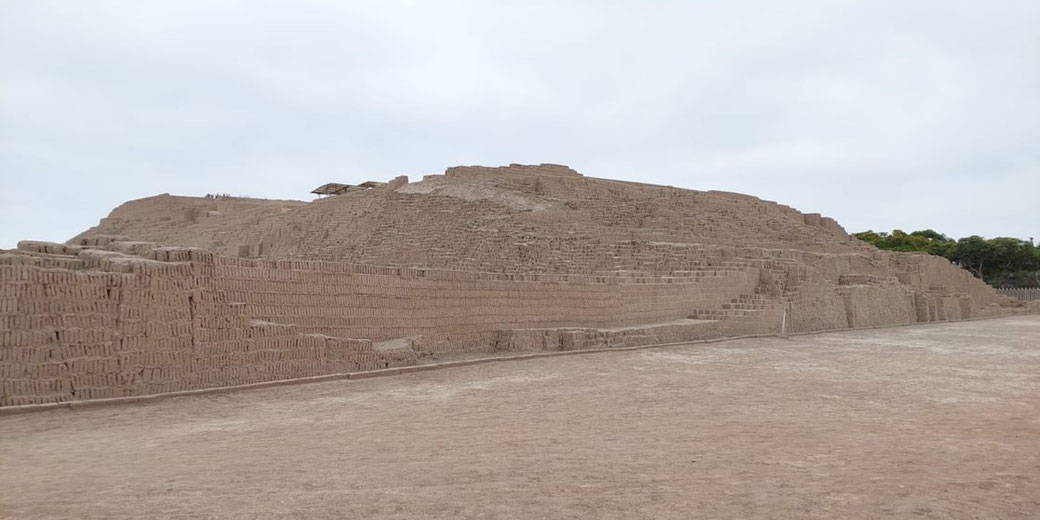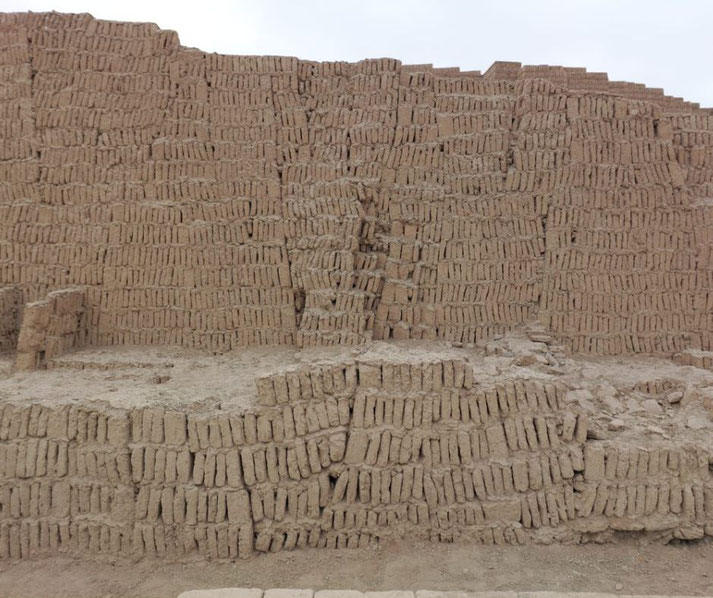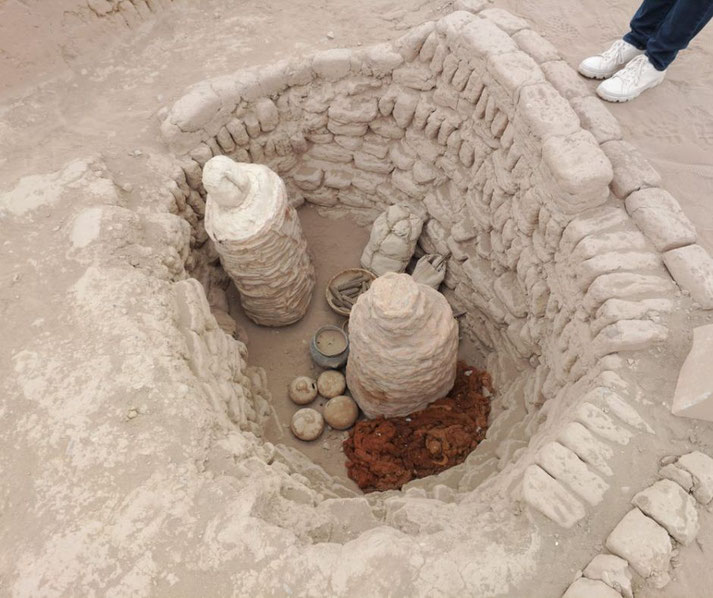Huaca Pucllana: The incredible ancient pyramid still standing in the heart of modern Lima

Appearing unexpectedly from among the dense urban streets of Miraflores district of Lima, visitors are often surprised to discover an impressive remnant of Peru’s pre-Inca past.
Composed of sun-dried bricks, this adobe pyramid measured approximately 22 metres in height, the equivalent of just over seven storeys, and it survived centuries of neglect, looting, and encroaching development.
Its sheer volume, measured by its approximate 22-metre height and construction from millions of adobe bricks, reflects the builders' ability to organise large projects.
As one of the few surviving structures from the Lima Culture, it offers valuable information about a civilisation that once thrived on the Pacific coast but vanished long before the Spanish conquest.
What is Huanca Pucllana?
Huaca Pucllana refers to a ceremonial and administrative centre constructed by the Lima Culture between 200 and 700 CE, when regional societies flourished along Peru’s central coast.
The site was built almost entirely from handmade adobe bricks and spans over six hectares and contains a central stepped pyramid, open plazas, courtyards, storage facilities, and ritual zones, arranged according to a deliberate, ordered layout.
Archaeological studies have identified distinct functional areas within the complex, suggesting a society governed by religious elites who wielded considerable influence over agricultural and spiritual life.
Evidence from surrounding burials and ceramic motifs suggests that the Lima Culture practiced ancestor veneration, engaged in textile production, and maintained networks of local exchange.
The name, applied long after the site's construction, derives from Quechua terms: “huaca,” meaning sacred object or location, and “pucllana,” which refers to ritual games or gatherings.
The name reflects later Andean reinterpretations of ancient sites through the lens of religious continuity, especially under Inca and post-Inca traditions.
Excavations have revealed multiple phases, initial construction followed by later episodes of occupation and modification, which demonstrate how the site adapted over several centuries to shifting cultural and political needs.
One of the most prominent excavation campaigns began in 1981 under the leadership of Peruvian archaeologist Isabel Flores Espinoza, whose team had uncovered ritual deposits, burial complexes, and architectural layers that had been hidden for centuries.
The pyramid’s structure displays a distinctive “bookshelf” brick arrangement, in which vertically placed adobe units allowed for slight flexibility under earthquake forces.
As a result, Huaca Pucllana withstood repeated earthquakes that would have destroyed more rigid constructions.
The upper levels are platforms for ritual activities, whereas the lower ones likely housed support roles, such as the storage of offerings or supplies required for ceremonies and feasting.
Conservation teams still reproduce this design and they make traditional adobe bricks by hand for repairs.
About 100,000 bricks are made each year to stabilise weak sections.

The important location of its construction
The builders of Huaca Pucllana selected the site with strategic and environmental awareness.
Located within the Rimac Valley on the central Peruvian coast, the structure occupied a fertile strip between the Andes and the Pacific Ocean, where rivers that descended from highland catchments supported irrigation channels that were essential for agriculture in an otherwise arid environment.
These water sources enabled the cultivation of cotton, maize, beans, and gourds, which the local economy relied upon for both subsistence and trade.
Adjacent gardens within the modern site replicate these ancient crops and have educational exhibits for visitors.
In addition to the agricultural benefits, the site also controlled important cultural and commercial routes that connected inland settlements with coastal fishing zones.
Marine life from the nearby ocean, such as anchovies and sharks, contributed to the local diet and also formed a critical part of religious offerings.
Archaeological finds indicate that such resources arrived through organised collection and redistribution, a practice that reinforced the authority of the religious class who managed ceremonial centres such as Huaca Pucllana.
Trade networks may have reached contemporaneous sites such as Huaca Huallamarca and Huaca Mateo Salado, which shared architectural features and cultural traits, and suggested a wider sphere of Lima Culture influence.
Positioned near the modern centre of Miraflores, the site would have overlooked a network of smaller villages and farming zones that helped support its ceremonial functions.
These peripheral communities must have supplied food, textiles, and labour as part of a wider system of mutual obligations, controlled by elites.
Through such relationships, the site maintained its economic importance and ceremonial status for centuries, even as other regional powers began to assert influence across the coast.
Its mysterious history
The history of Huaca Pucllana is partly obscure, largely because the Lima Culture left no written records and few long-lasting markers of political lineage or mythological tradition.
Knowledge of the site derives entirely from archaeological investigation, particularly stratigraphic excavation, radiocarbon analysis, and material comparisons with other Andean sites.
From these methods, researchers have traced the pyramid’s origin to the Early Intermediate Period, when ceremonial authority centred on large, regional religious hubs rather than imperial control.
Prior to systematic excavation, the site had suffered extensive damage due to urban growth, looting, and quarrying.
During the colonial period, residents of Lima had dismantled parts of the pyramid to use its adobe bricks as building materials, and sections of the structure had disappeared beneath earth and refuse.
Serious preservation efforts began only in 1981, when Peruvian archaeologist Isabel Flores Espinoza led an extensive programme to uncover, document, and restore the remaining structures.
Her work had rescued the monument from total destruction and had also inspired similar conservation efforts across Lima.
Subsequent excavations revealed that the site had experienced repeated phases of reuse by later groups, including the Wari, Ychsma, and eventually the Inca.
Evidence of Wari tombs constructed within the pyramid itself showed that later cultures had treated the structure as sacred, even if they no longer understood its original purpose.
These tombs are dated to between 800 and 1000 CE and had often contained offerings such as finely woven textiles, wooden masks, and ceremonial ceramics.
Over time, Huaca Pucllana had accumulated layers of ritual practice and funerary custom alongside later architectural interventions, which produced a layered record that successive inhabitants had added to over centuries.
How was it built?
Construction of Huaca Pucllana involved the production and placement of millions of adobe bricks, each moulded from a mixture of sand, clay, water, and plant fibres, then left to dry under the sun.
These bricks, usually rectangular in shape and consistent in size, were laid vertically in tightly packed rows with gaps between them to absorb earthquake shocks.
The builders knew how to make foundations that were flexible yet stable, which allowed the structure to remain intact through multiple earthquakes over the centuries.

The building process appear to have unfolded gradually, likely across generations, and each major phase contributed additional platforms, staircases, and enclosed walls.
Workers carried bricks and materials in hand-woven baskets, and they used basic tools made from wood, bone, and stone.
Marks found on some bricks suggest that different groups or workshops produced them in batches, possibly under state supervision or as part of a labour tax system that required local communities to contribute time and effort to public construction projects.
Some bricks bear stamped or incised marks, which archaeologists have proposed may have been identifiers for work groups or groups of craftsmen, although their precise meaning is uncertain.
Certain sections of the pyramid contain offering pits filled with plant and animal remnants and ceramics, which indicates that construction followed ritual guidelines.
Builders sometimes deposited small sacrifices (fish bones, textiles, or ceramic vessels) beneath new walls or platforms before they proceeded, which suggests that spiritual preparation formed part of the building process.
These practices mirrored broader Andean beliefs about reciprocity with divine forces and the sanctity of public architecture.
In some cases, animal remains have been radiocarbon dated to match key phases of expansion, reinforcing the connection between sacred timekeeping and construction.
The shocking religious uses of the site
Excavations have showed that Huaca Pucllana served as a major religious centre where ritual practices included animal and human sacrifice.
As mentioned above, offerings discovered beneath the pyramid include marine animals such as sharks, sea lions, and fish, often buried with ceremonial ceramics.
The selection of marine species (especially sharks, which some scholars interpret as symbols of strength or divine judgment based on their size and predatory nature) proves the spiritual relationship between the people and the nearby ocean.

More disturbing evidence comes from the discovery of human bones, particularly women and children buried in ritual spaces.
Some of the bones show signs of violent death, such as skull fractures and dismemberment.
These burials, often accompanied by fine textiles and decorative items, suggest that victims were selected carefully and killed as part of structured religious observances rather than random violence.
Radiocarbon dating of these sacrifices places many of them within the sixth and seventh centuries CE, suggesting that ritual violence intensified during the later phases of Lima occupation.
Restricted access to upper platforms points to a small group of priests who controlled the most sacred areas, which limited participation to religious specialists and their attendants.
Ceremonial pathways and enclosed spaces demonstrate how rituals excluded most members of the population, who may have gathered in surrounding plazas to witness or honour the events that took place above.
By separating elite from commoner in both space and ritual knowledge, the Lima Culture preserved strict religious hierarchies and reinforced spiritual authority through spectacle and sacrifice.

Visiting the site today
Since the 1980s, Huaca Pucllana has been transformed into a public archaeological complex where visitors can explore preserved and reconstructed portions of the original pyramid.
Run by the Municipality of Miraflores, the site now includes a museum that displays artefacts recovered from excavations, including ceramics, tools, and burial goods that help explain daily life and ceremonial practices at the complex.
Guided tours operate throughout the day and provide detailed commentary on the site's architectural features, religious importance, and conservation work that continues.
The museum opened officially in 1984, and the site now receives over 100,000 visitors per year.
Efforts to preserve the structure rely on traditional building techniques, as modern workers replicate original adobe bricks by hand and use them to stabilise weakened areas, which helps maintain visual and structural continuity with the ancient design.
Information panels throughout the site explain the history and construction methods in multiple languages, which makes the site accessible to both local residents and international visitors.
Adjacent gardens feature native plants cultivated by the Lima Culture, including cotton, maize, and medicinal herbs.
Educational exhibits explain how these plants served both economic and ritual purposes, providing insight into the daily rhythms of life in a ceremonial society.
The site also hosts school visits, public lectures, and rotating exhibitions that connect Peruvians with their ancient heritage through direct experience.
From the summit of the pyramid, visitors can observe the city of Lima that stretches outward in all directions, a reminder that even in a rapidly changing metropolis, remnants of the past still rise above the concrete and steel.
As one of the few ceremonial pyramids from the pre-Inca period that survive, Huaca Pucllana continues to be a living archive.
What do you need help with?
Download ready-to-use digital learning resources
Copyright © History Skills 2014-2025.
Contact via email
With the exception of links to external sites, some historical sources and extracts from specific publications, all content on this website is copyrighted by History Skills. This content may not be copied, republished or redistributed without written permission from the website creator. Please use the Contact page to obtain relevant permission.





